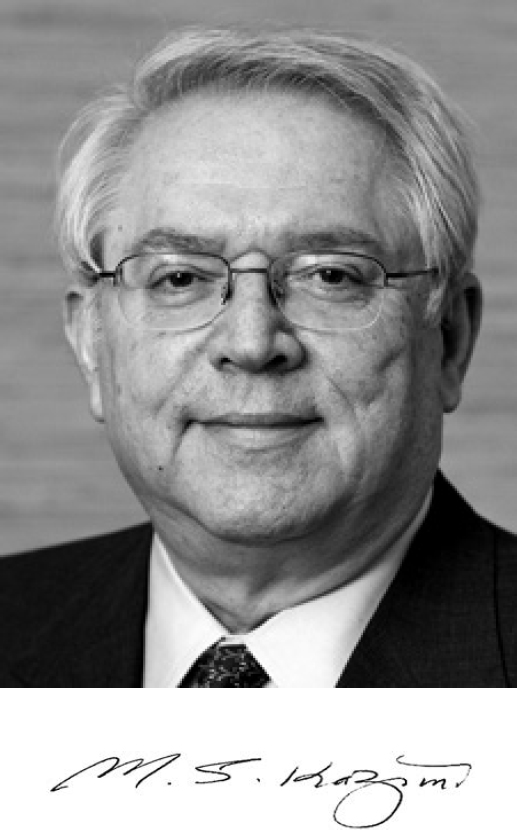MUJID S. KAZIMI
1947–2015
Elected in 2012
“For contributions to technologies for the nuclear fuel cycle and reactor safety.”
BY MICHAEL CORRADINI AND NEIL TODREAS
MUJID S. KAZIMI, Tokyo Electric Power Company Professor of Nuclear Science and Engineering at the Massachusetts Institute of Technology, lifelong educator and international leader in nuclear reactor engineering, reactor safety, and the nuclear fuel cycle, died July 1, 2015, at the age of 67 while traveling in China. He had a heart attack.
Mujid was born in Jerusalem November 20, 1947, and later moved with his family to Amman, Jordan. After earning his bachelor’s degree in nuclear engineering from Alexandria University in Egypt in 1969, he came to MIT, where he earned his SM in 1971 and PhD in 1973.
He worked briefly at Westinghouse Electric Corp. and Brookhaven National Laboratory before joining the MIT faculty in 1976. He held faculty appointments in the Department of Nuclear Science and Engineering (chair, 1989–1997) and Department of Mechanical Engineering, and was director of both MIT’s Center for Advanced Nuclear Energy Systems and the Kuwait-MIT Center for Natural Resources and the Environment.
He was a world-renowned authority on the design and analysis of nuclear power plants, nuclear safety, and the nuclear fuel cycle (both fission and fusion). He and his students made many important technological advances designed
to enhance the safety and economics of nuclear power, including the developments of annular nuclear fuel with internal and external cooling, and a ceramic fuel cladding made of silicon carbide to replace the zirconium alloy cladding used in most reactor fuel. His research group also made influential contributions to the development of technological strategies for the nuclear fuel cycle.
He was an active member of the nuclear engineering faculty at MIT, and his contributions to the development of the department and the field of nuclear engineering were extraordinary. He supervised more than 100 PhD and MS theses, and coauthored the widely used two-volume textbook Nuclear Systems (with Neil Todreas; CRC Press, 1989).
Both before and after his service as head of the Nuclear Science and Engineering Department, he took on many other leadership positions at MIT. At the time of his death he was chair of the department’s graduate committee, a post he had held for many years. He was a wise and judicious administrator, a talented negotiator, and a selfless and always constructive colleague.
He was also much in demand as an advisor on nuclear research and education to governments and other organizations around the world. He served on and led numerous professional technical committees, review panels, and advisory boards, including the US Department of Energy’s Nuclear Energy Advisory Committee, for which he chaired the subcommittee on nuclear reactor technology.
Mujid received many honors for his scientific and engineering work. He was a member of the International Nuclear Energy Academy and American Association for the Advancement of Science, and a fellow of the American Nuclear Society. In 2011 he received the TAKREEM Arab Achievement Award for Scientific and Technological Achievement, and in the same year he was awarded the Kuwait Prize in Applied Sciences by the Kuwait Foundation for the Advancement of Science.
Throughout his life he was a strong advocate for educational and scientific advancement across the Arab world, an active member of many educational, humanitarian, and
developmental organizations in the Middle East. He served on the board of trustees of Al-Quds University in Jerusalem, a committee on the rejuvenation of scientific research in Kuwait, and the international advisory board on nuclear energy for the United Arab Emirates. While a student he was president of the MIT Arab Students’ Organization, and he continued to support it as a faculty member. His leadership on scientific and educational development in the Middle East was a source of inspiration and pride for MIT’s many Arab students and alumni.
What this long list of roles, achievements, honors, and service cannot adequately convey are the very special qualities of Mujid as a teacher, mentor, and colleague. A modest and unassuming man despite his eminence, he was kind, thoughtful, patient, and always gracious and respectful toward his students and his colleagues. His dedication and loyalty to his students were inspirational. He was truly a gentleman and a scholar in every sense.
Mujid addressed great challenges with diligence, humility, and effectiveness. He represented the very best of what an educator and researcher should be in engineering. His friends and colleagues are deeply grateful for the honor of having known and served with him. He will be greatly missed.
Mujid is survived by his wife of 41 years, Nazik Denny, daughter Yasmeen and sons Marwan and Omar, and three grandchildren.





